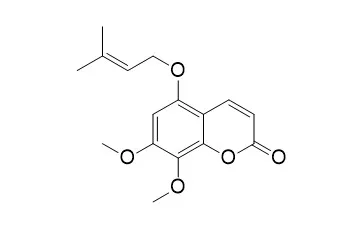| In vitro: |
| J Agric Food Chem . 2013 Jul 3;61(26):6465-6476. | | Studies on nonenzymatic oxidation mechanisms in neobetanin, betanin, and decarboxylated betanins[Pubmed: 23789904] | | A comprehensive nonenzymatic oxidation mechanism in betanin plant pigment as well as its derivatives, 2-decarboxybetanin, 17-decarboxybetanin, 2,17-bidecarboxybetanin, and neobetanin, in the presence of ABTS cation radicals was investigated by LC-DAD-ESI-MS/MS. The main compounds formed during the first step of betanin and 2-decarboxybetanin oxidation are 2-decarboxy-2,3-dehydrobetanin and 2-decarboxyneobetanin, respectively. In contrast to betanin, the reaction mechanism for 2-decarboxybetanin includes more oxidation pathways. Parallel transformation of 2-decarboxybetanin quinone methide produces neoderivatives according to an alternative reaction that omits the presumably more stabile intermediate 2-decarboxy-2,3-dehydrobetanin. The main oxidation product after the first reaction step for both 17-decarboxybetanin and 2,17-bidecarboxybetanin is 2,17-decarboxy-2,3-dehydrobetanin. This product is formed through irreversible decarboxylation of the 17-decarboxybetanin quinone methide or by oxidation of 2,17-bidecarboxybetanin. Oxidation of neobetanin results primarily in a formation of 2-decarboxy-2,3-dehydroneobetanin by a decarboxylative transformation of the formed neobetanin quinone methide. The elucidated reaction scheme will be useful in interpretation of redox activities of betalains in biological tissues and food preparations. | | Acta Sci Pol Technol Aliment . Jul-Sep 2016;15(3):257-265. | | The effect of thermal treatment on antioxidant capacity and pigment contents in separated betalain fractions[Pubmed: 28071025] | | Background: Increased consumption of fruits and vegetables significantly reduces the risk of cardio-vascular disease. This beneficial effect on the human organism is ascribed to the antioxidant compounds these foods contain. Unfortunately, many products, particularly vegetables, need to be subjected to thermal processing before consumption. The aim of this study was to determine the effect of such thermal treatment on the antioxidant capacity and pigment contents in separated fractions of violet pigments (betacyanins) and yellow pigments (betaxanthins and betacyanins).
Methods: Fractions of violet and yellow pigments were obtained by separation of betalain pigments from fresh roots of 3 red beet cultivars using column chromatography and solid phase extraction (SPE). The betalain pigment content was determined in all samples before and after thermal treatment (90°C/30 min) by spectrophotometry, according to Nilsson's method [1970] and antioxidant capacity was assessed based on ABTS. Betalain pigments in the separated fractions were identified using HPLC-MS.
Results: After thermal treatment of betacyanin fractions a slight, but statistically significant degradation of pigments was observed, while the antioxidant capacity of these fractions did not change markedly. Losses of betacyanin content amounted to 13-15% depending on the cultivar, while losses of antioxidant capacity were approx. 7%. HPLC/MS analyses showed that before heating, betanin was the dominant pigment in the betacyanin fraction, while after heating it was additionally 15-decarboxy-betanin. Isolated fractions of yellow pigments in red beets are three times less heat-resistant than betacyanin fractions. At losses of yellow pigment contents in the course of thermal treatment reaching 47%, antioxidant capacity did not change markedly (a decrease by approx. 5%). In the yellow pigment fractions neobetanin was the dominant peak in the HPLC chromatogram, while vulgaxanthin was found in a much smaller area, whereas after heating additionally 2-decarboxy-2,3-dehydro-neobetanin was detected.
Conclusions: Both groups of betalain pigments (betacyanins and betaxanthins) exhibit antioxidant capacity before and after heating. Violet beatacyjanins are 3 times more stable when heated than yellow betaxanthins. |
|






 Cell. 2018 Jan 11;172(1-2):249-261.e12. doi: 10.1016/j.cell.2017.12.019.IF=36.216(2019)
Cell. 2018 Jan 11;172(1-2):249-261.e12. doi: 10.1016/j.cell.2017.12.019.IF=36.216(2019) Cell Metab. 2020 Mar 3;31(3):534-548.e5. doi: 10.1016/j.cmet.2020.01.002.IF=22.415(2019)
Cell Metab. 2020 Mar 3;31(3):534-548.e5. doi: 10.1016/j.cmet.2020.01.002.IF=22.415(2019) Mol Cell. 2017 Nov 16;68(4):673-685.e6. doi: 10.1016/j.molcel.2017.10.022.IF=14.548(2019)
Mol Cell. 2017 Nov 16;68(4):673-685.e6. doi: 10.1016/j.molcel.2017.10.022.IF=14.548(2019)